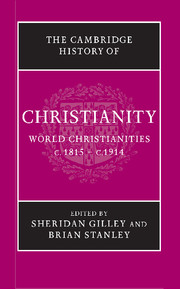Book contents
- Frontmatter
- 1 Introduction
- PART I CHRISTIANITY AND MODERNITY
- PART II THE CHURCHES AND NATIONAL IDENTITIES
- PART III THE EXPANSION OF CHRISTIANITY
- 26 African-American Christianity
- 27 Christian missions, antislavery and the claims of humanity, c.1813–1873
- 28 The Middle East: western missions and the Eastern churches, Islam and Judaism
- 29 Christians and religious traditions in the Indian empire
- 30 Christianity in East Asia: China, Korea and Japan
- 31 Christianity in Indochina
- 32 Christianity as church and story and the birth of the Filipino nation in the nineteenth century
- 33 Christianity in Australasia and the Pacific
- 34 Missions and empire, c.1873–1914
- 35 Ethiopianism and the roots of modern African Christianity
- 36 The outlook for Christianity in 1914
- Select General Bibliography
- Chapter Bibliography
- Index
- References
30 - Christianity in East Asia: China, Korea and Japan
from PART III - THE EXPANSION OF CHRISTIANITY
Published online by Cambridge University Press: 28 March 2008
- Frontmatter
- 1 Introduction
- PART I CHRISTIANITY AND MODERNITY
- PART II THE CHURCHES AND NATIONAL IDENTITIES
- PART III THE EXPANSION OF CHRISTIANITY
- 26 African-American Christianity
- 27 Christian missions, antislavery and the claims of humanity, c.1813–1873
- 28 The Middle East: western missions and the Eastern churches, Islam and Judaism
- 29 Christians and religious traditions in the Indian empire
- 30 Christianity in East Asia: China, Korea and Japan
- 31 Christianity in Indochina
- 32 Christianity as church and story and the birth of the Filipino nation in the nineteenth century
- 33 Christianity in Australasia and the Pacific
- 34 Missions and empire, c.1873–1914
- 35 Ethiopianism and the roots of modern African Christianity
- 36 The outlook for Christianity in 1914
- Select General Bibliography
- Chapter Bibliography
- Index
- References
Summary
The nineteenth-century history of Christianity in China, Korea and Japan has some features in common. In each case it was seen at times as a danger to the authorities and the elite, whether as potential internal rebellion or as a link to a foreign threat. At times it also appealed to alienated elites as well as to the lower classes, and was seen by yet others in all three countries as a perceived path to modernisation of the state and society. However, the Christian histories of the three also seem sufficiently distinct from one another to describe them separately, and that is what this chapter will do.
China
In the long century from the early 1800s to 1914, Christianity evolved from the status of an illegal heterodox sect to that of a religion under foreign missionary control, closely associated with the west and its privileged position in China gained through the unequal treaties. In the years after 1900, however, currents of change in Chinese society involved some urban sectors of the Christian (mainly Protestant) community, both foreign and Chinese, in reform, modernisation and nation-building projects.
Christianity 1807–1860: Catholic continuities and Protestant beginnings
As a result of the early mission efforts of the Roman Catholic Church, including those of the Jesuit pioneer Matteo Ricci (1552–1610), and owing to a generally favourable stance of the imperial authorities towards the missionaries, in the early 1700s there were about 300,000 Chinese Catholics. But the imperial decree of 1724 which proscribed Christianity and expelled all missionaries (except a handful of Jesuits who were kept on to operate the Bureau of Astronomy at the court in Peking) resulted in a steady decline in the Catholic community.
- Type
- Chapter
- Information
- The Cambridge History of Christianity , pp. 493 - 512Publisher: Cambridge University PressPrint publication year: 2005

